While some mushrooms have
mysterious-sounding names, many are named for what they look like, such as
hen-of-the-woods, pom porn, oyster, and black trumpet. Here's a guide to
the more exotic varieties that are now more available.
 Beech
(Hypsyzygus tessulatus): Also called clam shell or
hon-shimeji. This mushroom variety has the most sensational and sensual
texture imaginable. Beech mushrooms are bouncy, resilient, almost crunchy,
and very juicy. With a mild mushroom flavor and nutty undertone, beech
mushrooms largely take on other flavors during cooking. A quick saute in
olive oil or butter or a quick grilling (brushed lightly with oil) shows
them off best. They also stand up well in soups, stews, stir-fries, and
salads. The flavor of beech mushrooms can be enhanced with a smidgen of
minced garlic, a pinch of fresh herbs, and a splash of wine or sherry. And
they are terrific alongside mashed potatoes, soft polenta, and other foods
with a creamy consistency.
Beech
(Hypsyzygus tessulatus): Also called clam shell or
hon-shimeji. This mushroom variety has the most sensational and sensual
texture imaginable. Beech mushrooms are bouncy, resilient, almost crunchy,
and very juicy. With a mild mushroom flavor and nutty undertone, beech
mushrooms largely take on other flavors during cooking. A quick saute in
olive oil or butter or a quick grilling (brushed lightly with oil) shows
them off best. They also stand up well in soups, stews, stir-fries, and
salads. The flavor of beech mushrooms can be enhanced with a smidgen of
minced garlic, a pinch of fresh herbs, and a splash of wine or sherry. And
they are terrific alongside mashed potatoes, soft polenta, and other foods
with a creamy consistency.
Chanterelle (Cantharellus cibarius): Also called
girolle or Pfifferling. While many "wild" mushrooms are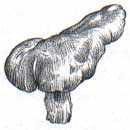 now cultivated, chanterelles defy cultivation. They will be expensive when
you come across them because they are hand-picked by experts in the wild.
Chanterelles are easily recognized by their delicate orange or apricot
color and trumpet shape. Black trumpets (Craterellus fallax) are a
similar, related variety. The texture of chanterelles should be firm yet
spongy and the flavor mild and just a bit woodsy. Some have a subtle
apricot nuance. They are especially delicious with cream sauces, chicken,
and pasta.
now cultivated, chanterelles defy cultivation. They will be expensive when
you come across them because they are hand-picked by experts in the wild.
Chanterelles are easily recognized by their delicate orange or apricot
color and trumpet shape. Black trumpets (Craterellus fallax) are a
similar, related variety. The texture of chanterelles should be firm yet
spongy and the flavor mild and just a bit woodsy. Some have a subtle
apricot nuance. They are especially delicious with cream sauces, chicken,
and pasta.
 Cremini
(Agaricus bisporus): Also called crimini or brown
mushrooms. Some years ago, the brown color of these wonderful mushrooms
was bred out of the variety, resulting in the very common white button
mushrooms. It was only after cooks sought out brown mushrooms with more
flavor that cremini became popular again. Cremini mushrooms have a flavor
similar to white mushrooms, except deeper, a bit bolder and more mushroomy.
It's an earthy yet sophisticated flavor that greatly enhances the flavors
of other foods. Cremini can be sliced or chopped and sauteed, then used in
stuffings and soups. They are also perfect for stuffed mushroom caps.
Cremini
(Agaricus bisporus): Also called crimini or brown
mushrooms. Some years ago, the brown color of these wonderful mushrooms
was bred out of the variety, resulting in the very common white button
mushrooms. It was only after cooks sought out brown mushrooms with more
flavor that cremini became popular again. Cremini mushrooms have a flavor
similar to white mushrooms, except deeper, a bit bolder and more mushroomy.
It's an earthy yet sophisticated flavor that greatly enhances the flavors
of other foods. Cremini can be sliced or chopped and sauteed, then used in
stuffings and soups. They are also perfect for stuffed mushroom caps.
Enoki (Flammulina velutipes, formerly Collybia
velutipes): Also called enokitake, enokidake, and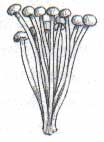 golden needle mushrooms. These waifs of the mushroom world are easily
identified by their long, skinny stems and tiny caps, which are the size
of pencil erasers. They grow in clusters and are sold in vacuum-packed
pouches to extend their shelf life. Trim off about 1" from the stems at
the bottom, where the fused stems begin to separate. The taste of these
mushrooms is fairly bland, but the texture of the caps is firm and bouncy.
Because they are so exotically beautiful, enoki are often added to salads
and open-faced sandwiches, dropped into a stir-fry or hot soup at the last
moment, or used as a garnish. They are best when eaten raw or just
slightly cooked.
golden needle mushrooms. These waifs of the mushroom world are easily
identified by their long, skinny stems and tiny caps, which are the size
of pencil erasers. They grow in clusters and are sold in vacuum-packed
pouches to extend their shelf life. Trim off about 1" from the stems at
the bottom, where the fused stems begin to separate. The taste of these
mushrooms is fairly bland, but the texture of the caps is firm and bouncy.
Because they are so exotically beautiful, enoki are often added to salads
and open-faced sandwiches, dropped into a stir-fry or hot soup at the last
moment, or used as a garnish. They are best when eaten raw or just
slightly cooked.
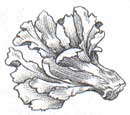 Hen-of-the-Woods
(Grifola frondosa): Also called maitake, sheep's head,
and dancing butterfly mushrooms. When you come across hen-of-the-woods,
you will see a cluster of ruffled-looking caps and stems attached at a
base. These clumps can be enormous, sometimes growing several feet wide.
Both the stems and caps can be eaten, but many people prefer the stem over
the cap because the stem has a firmer texture. The whole clump is
generally firm in texture compared with other mushrooms, yet tender and a
bit crumbly, with a nutty, woodsy flavor and a hint of garlic. Pull apart
the cluster to make smaller portions. Hen-of-the-woods stands up well to
simmering and braising. Great with chicken or veal in cream sauce or with
beef stroganoff.
Hen-of-the-Woods
(Grifola frondosa): Also called maitake, sheep's head,
and dancing butterfly mushrooms. When you come across hen-of-the-woods,
you will see a cluster of ruffled-looking caps and stems attached at a
base. These clumps can be enormous, sometimes growing several feet wide.
Both the stems and caps can be eaten, but many people prefer the stem over
the cap because the stem has a firmer texture. The whole clump is
generally firm in texture compared with other mushrooms, yet tender and a
bit crumbly, with a nutty, woodsy flavor and a hint of garlic. Pull apart
the cluster to make smaller portions. Hen-of-the-woods stands up well to
simmering and braising. Great with chicken or veal in cream sauce or with
beef stroganoff.
Morel (Morchella angusticeps or Morchella elata):
Elegant and expensive are words that come to mind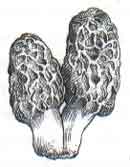 at the mention of morels. Perhaps the most easily recognized mushroom,
morels have an unusual shape: a rounded, hollow elongated cone with a
honeycomb-like, spongy cap and a hollow stem. They have a rich flavor that
suggests nuts or spice. Morels take especially well to creamy sauces,
flavoring and soaking up the sauce in a delicious way. Wonderful with
elegant seafoods, poultry, and veal, morels also make a great addition to
vegetable dishes. Dried morels are quite good and some of them are lightly
smoked during the drying process, boosting their flavor even more.
at the mention of morels. Perhaps the most easily recognized mushroom,
morels have an unusual shape: a rounded, hollow elongated cone with a
honeycomb-like, spongy cap and a hollow stem. They have a rich flavor that
suggests nuts or spice. Morels take especially well to creamy sauces,
flavoring and soaking up the sauce in a delicious way. Wonderful with
elegant seafoods, poultry, and veal, morels also make a great addition to
vegetable dishes. Dried morels are quite good and some of them are lightly
smoked during the drying process, boosting their flavor even more.
 Oyster
(Pleurotus): Also called pleurotte. A rainbow of color will
greet you in the oyster mushroom section of food markets: They grow in
hues ranging from silver, cream, white, and buff, to golden, yellow, pale
blue, lavender, pink, gray, and black. Cream is the most common color, and
don't worry about trying every color variety. Most of the color fades
during cooking, and the flavors of each variety are similar. Oyster
mushrooms have a delicate earthy flavor, not bold at all, and will taste
best when cooked simply and quickly. A very short saute in butter or olive
oil until just wilted and a light sprinkle of salt and pepper are all that
is needed. They can also be quickly grilled or broiled, then dressed with
a vinaigrette. Or try them scattered over seafood. Delicate oyster
mushrooms begin to decay quickly, so buy them fresh and dry, and use them
as soon as you can.
Oyster
(Pleurotus): Also called pleurotte. A rainbow of color will
greet you in the oyster mushroom section of food markets: They grow in
hues ranging from silver, cream, white, and buff, to golden, yellow, pale
blue, lavender, pink, gray, and black. Cream is the most common color, and
don't worry about trying every color variety. Most of the color fades
during cooking, and the flavors of each variety are similar. Oyster
mushrooms have a delicate earthy flavor, not bold at all, and will taste
best when cooked simply and quickly. A very short saute in butter or olive
oil until just wilted and a light sprinkle of salt and pepper are all that
is needed. They can also be quickly grilled or broiled, then dressed with
a vinaigrette. Or try them scattered over seafood. Delicate oyster
mushrooms begin to decay quickly, so buy them fresh and dry, and use them
as soon as you can.
Porcini (Boletus edulis): Also called Bolete, King
Bolete, porcino, cepe, or Steinpilze. Large and precious,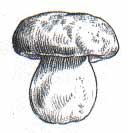 perhaps the greatest of all mushrooms, porcini defy cultivation. Great
celebrations follow porcini seasons throughout Europe. The caps can grow
up to a foot across! The stems can be quite bulbous but are delicious and
should not be discarded. Although some wild porcini come to market from
the West Coast, most are imported. They are very expensive, both fresh and
dried. But the reward is a deep, meaty, woodsy flavor and tender, beefy
texture. The caps, or even whole fresh porcini cut into thick slices, are
ideal for grilling. Just brush with olive oil and sprinkle with salt and
pepper. Simple is best when it comes to cooking these treasures of the
forest. Dried porcini are also sensational. They have such a deep, robust
taste that 1/2 ounce or less is enough to flavor an entire pot of pasta
sauce.
perhaps the greatest of all mushrooms, porcini defy cultivation. Great
celebrations follow porcini seasons throughout Europe. The caps can grow
up to a foot across! The stems can be quite bulbous but are delicious and
should not be discarded. Although some wild porcini come to market from
the West Coast, most are imported. They are very expensive, both fresh and
dried. But the reward is a deep, meaty, woodsy flavor and tender, beefy
texture. The caps, or even whole fresh porcini cut into thick slices, are
ideal for grilling. Just brush with olive oil and sprinkle with salt and
pepper. Simple is best when it comes to cooking these treasures of the
forest. Dried porcini are also sensational. They have such a deep, robust
taste that 1/2 ounce or less is enough to flavor an entire pot of pasta
sauce.
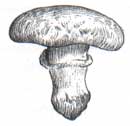 Portobello
(Agaricus bisporus): Also called portabella. When
cremini mushrooms are left to grow larger, they turn into portobellos.
Cultivation of portobellos has flourished in recent years and their price
is coming down as supply increases. In a way, they are an inexpensive
substitute for porcini mushrooms. They have a deep, meaty flavor and
texture. The stems are tough and woody, often removed and added to soups
and stock for flavor, but you can also slice and saute them. The large
caps are the real draw in portobellos. They are wonderful for grilling or
broiling whole. They can also become "burgers" or a mushroom "pizza" crust
when topped with tomato and cheese, then baked. When thinly sliced, the
caps make a pretty arrangement over traditional pizza. If using in light
sauces, scrape out the dark gills from the undersides of the caps to avoid
darkening the sauce.
Portobello
(Agaricus bisporus): Also called portabella. When
cremini mushrooms are left to grow larger, they turn into portobellos.
Cultivation of portobellos has flourished in recent years and their price
is coming down as supply increases. In a way, they are an inexpensive
substitute for porcini mushrooms. They have a deep, meaty flavor and
texture. The stems are tough and woody, often removed and added to soups
and stock for flavor, but you can also slice and saute them. The large
caps are the real draw in portobellos. They are wonderful for grilling or
broiling whole. They can also become "burgers" or a mushroom "pizza" crust
when topped with tomato and cheese, then baked. When thinly sliced, the
caps make a pretty arrangement over traditional pizza. If using in light
sauces, scrape out the dark gills from the undersides of the caps to avoid
darkening the sauce.
Shiitake (Lentinus edodes): Also called black
mushrooms, Chinese black mushrooms, black forest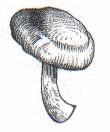 mushrooms, and golden oak mushrooms. Here we have one of the most
successfully cultivated mushrooms. The dark, almost pointy caps range from
just 1" to a very large 8" in diameter. The color of the caps is usually
dark brown, almost black, but sometimes you will find them with a
variegated or crackled beige appearance. The wonderful woodsy aroma and
flavor of shiitake intensifies when the mushroom is dried. Fresh shiitake
should be firm and dry. The stems are always tough and should be re-moved
before using. Shiitake can be grilled or broiled and they can star in
simple stir-fries. Incidentally, shiitake mushrooms were used as models
for the dancing and singing mushrooms in the movie Fantasia.
mushrooms, and golden oak mushrooms. Here we have one of the most
successfully cultivated mushrooms. The dark, almost pointy caps range from
just 1" to a very large 8" in diameter. The color of the caps is usually
dark brown, almost black, but sometimes you will find them with a
variegated or crackled beige appearance. The wonderful woodsy aroma and
flavor of shiitake intensifies when the mushroom is dried. Fresh shiitake
should be firm and dry. The stems are always tough and should be re-moved
before using. Shiitake can be grilled or broiled and they can star in
simple stir-fries. Incidentally, shiitake mushrooms were used as models
for the dancing and singing mushrooms in the movie Fantasia.
 Truffles
(Tuber spp.): Looks aren't everything. At first sight, a
truffle looks like a lumpy, warty, rough, and irregularly shaped mass. But
the flavor is smooth as velvet. Truffles are highly prized fungi that grow
underground, most abundantly beneath certain oak and hickory trees in
France and Italy. They are extremely expensive because it takes keen pigs
and dogs to sniff out their spontaneous subterranean locations in the fall
and winter. The average truffle is the size of a walnut, but they can grow
up to 6" across. Many varieties exist, but black and white are the most
important. Black truffles (nicknamed black diamonds) come from the
Perigord region of France. The color is actually a dark brown or grayish
purple-black. They have an incredibly earthy aroma and rich, subtle flavor
with nutty under-tones. Slight cooking brings out the best flavor. White
truffles are more fragrant and pungent, tan or light brown in color, and
grow abundantly in the Piedmont region of Italy. Their musky, earthy aroma
and flavor includes nuances of garlic and aged cheese, with an occasional
peppery bite. White truffles are almost always added raw to Italian
dishes, frequently shaved into wafers over pasta, risotto, and cheese
sauces. When purchasing truffles, go by aroma. To store them, bury the
truffles in rice grains and refrigerate up to 10 days. Use the
truffle-flavored rice too. For an economical way to enjoy the flavor of
truffles, buy truffle oil, store it in the refrigerator, and use within 1
year. Truffle oil is wonderful drizzled over bread, salads, pasta,
risotto, polenta, seafood, or vegetables. Canned truffles are also
available, but they have much less flavor than fresh and shrink to half
their size, creating a denser consistency and darker color.
Truffles
(Tuber spp.): Looks aren't everything. At first sight, a
truffle looks like a lumpy, warty, rough, and irregularly shaped mass. But
the flavor is smooth as velvet. Truffles are highly prized fungi that grow
underground, most abundantly beneath certain oak and hickory trees in
France and Italy. They are extremely expensive because it takes keen pigs
and dogs to sniff out their spontaneous subterranean locations in the fall
and winter. The average truffle is the size of a walnut, but they can grow
up to 6" across. Many varieties exist, but black and white are the most
important. Black truffles (nicknamed black diamonds) come from the
Perigord region of France. The color is actually a dark brown or grayish
purple-black. They have an incredibly earthy aroma and rich, subtle flavor
with nutty under-tones. Slight cooking brings out the best flavor. White
truffles are more fragrant and pungent, tan or light brown in color, and
grow abundantly in the Piedmont region of Italy. Their musky, earthy aroma
and flavor includes nuances of garlic and aged cheese, with an occasional
peppery bite. White truffles are almost always added raw to Italian
dishes, frequently shaved into wafers over pasta, risotto, and cheese
sauces. When purchasing truffles, go by aroma. To store them, bury the
truffles in rice grains and refrigerate up to 10 days. Use the
truffle-flavored rice too. For an economical way to enjoy the flavor of
truffles, buy truffle oil, store it in the refrigerator, and use within 1
year. Truffle oil is wonderful drizzled over bread, salads, pasta,
risotto, polenta, seafood, or vegetables. Canned truffles are also
available, but they have much less flavor than fresh and shrink to half
their size, creating a denser consistency and darker color.
Wood Ear (Auricularia polytricha, A. auricula):
Also called tree ears and cloud ears. These slippery,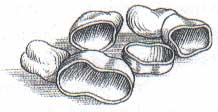 black-brown, wafer-thin, petal-like mushrooms were once available only
dried (they easily reconstitute and look similar to the fresh variety,
which is becoming more available). They have very little flavor and are
used mostly for their slightly crunchy texture. You can easily recognize
wood ears in Chinese dishes such as hot and sour soup and moo shu pork.
Fresh wood ears need only a brief rinsing and blanching. Dried wood ears
will keep well for several years. When buying the dried version, choose
the tiniest ones that you can find; they blow up to 4 to 5 times their
size after soaking, and the huge ones will be very chewy.
black-brown, wafer-thin, petal-like mushrooms were once available only
dried (they easily reconstitute and look similar to the fresh variety,
which is becoming more available). They have very little flavor and are
used mostly for their slightly crunchy texture. You can easily recognize
wood ears in Chinese dishes such as hot and sour soup and moo shu pork.
Fresh wood ears need only a brief rinsing and blanching. Dried wood ears
will keep well for several years. When buying the dried version, choose
the tiniest ones that you can find; they blow up to 4 to 5 times their
size after soaking, and the huge ones will be very chewy.
Warning : Only mushroom experts should pick or
use fresh mushrooms in the wild. Identifying mushrooms in the wild can be
very tricky, and some varieties are poisonous and is fatal.
Related Links -

